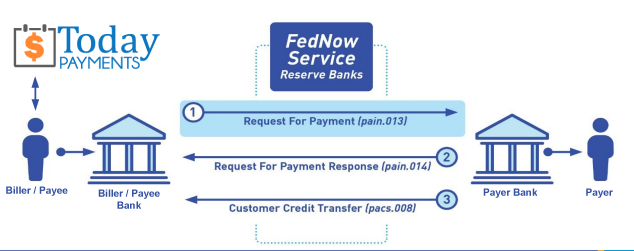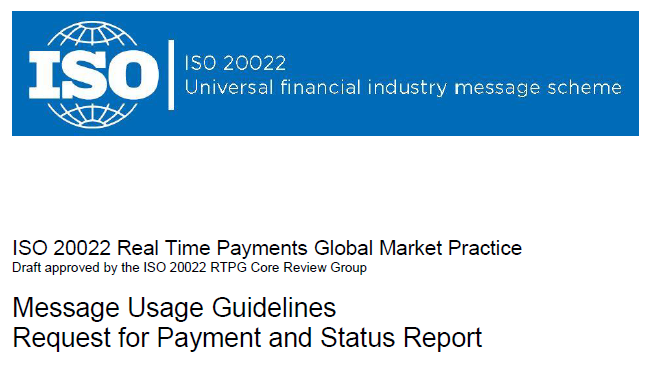RfP File Format
How to Import FedNow and Real-Time Payments Request for Payment Message File Format
RfP File Format – Real-Time Payment Requests via FedNow® and RTP®
RfP File Format enables U.S. payees to securely upload, import, and download structured Request for Payments (RfPs) using real-time payment networks like FedNow® and RTP®. Built on global ISO 20022 messaging standards, the format supports both one-time transactions and periodic recurring payments, giving businesses a powerful way to automate receivables and guarantee good funds with every transaction.
Payees can manage this workflow through secure online dashboards connected to their banks or credit unions—no paper, no delays, and no branch visits required.
From File to Funds—Structured Real-Time Payments for Every Business
Whether you’re billing a single customer or hundreds on a recurring basis, the RfP File Format allows you to process real-time payments with structure, scale, and security. Built on ISO 20022 standards and available in XML or .html formats, each file contains essential transaction data—payer alias, amount, invoice details, and a hosted payment link.
Once the file is uploaded via your payee dashboard, the FedNow® or RTP® rail delivers the request to the payer. Upon payment, the funds arrive instantly and irrevocably—giving sellers the green light to fulfill goods or services on time and without financial risk.
Key Features of the RfP File Format
ISO 20022-Compliant File Structure (XML
and HTML)
Each RfP file is built using globally accepted
ISO 20022 standards, allowing it to be read, routed, and
reconciled by participating U.S. financial institutions.
Upload, Import, and Download from Payee
Dashboards
Files can be securely uploaded through banking
dashboards, with full download access to confirmations, status
reports, and reconciliation logs.
Support for One-Time or Recurring
Transactions
Use the same RfP file format to request
one-time payments or set up recurring invoices weekly, monthly, or
on custom billing cycles.
FedNow® and RTP® Real-Time Rail
Integration
All RfPs are processed through instant payment
networks, ensuring funds are delivered to the payee within seconds
of payer authorization.
Alias-Based MID Routing for Clean
Reconciliation
Assign Merchant Identification Numbers
(MIDs) to phone numbers or email addresses to streamline
reconciliation and reduce data entry.
Hosted Payment Page in Every RfP Record
Every RfP includes a secure hosted payment page, enabling payers
to complete transactions from mobile or desktop with just one
click.
Guaranteed Good Funds Upon Completion
Once a payment is completed, funds are final and immediately
available to the payee—there are no holds, no reversals, and no
guesswork.
Why Businesses Choose TodayPayments.com for RfP File Uploads
1. Upload ISO 20022-compliant XML or HTML
RfP files 24/7
2. Trigger real-time payments using
FedNow® and RTP® networks
3. Collect guaranteed good
funds for both one-time and recurring transactions
4.
Automate reconciliation with alias-based MID support
5.
Provide payers with secure, hosted payment links on every request
6. Eliminate paperwork and delays with fully digital processing
7. Integrate real-time reporting into QuickBooks® Online and
other accounting systems
8. Onboard online—no in-person
bank visit required
To import FedNow and Real-Time Payments (RTP) Request for Payment (RfP) messages using ISO 20022 in file formats such as CSV, XML, or JSON, you need to ensure that these formats adhere to the necessary structure for ISO 20022 messaging. Here's a step-by-step guide on how to approach this task for each file format:
1. ISO 20022 Overview for Request for Payment (RfP)
ISO 20022 defines a rich data format for financial messaging, and for FedNow and RTP, the Pain.013 message type is typically used for Request for Payment (RfP). The basic structure of the message includes:
- Debtor Information: The party sending the payment.
- Creditor Information: The party requesting the payment.
- Amount: The transaction amount.
- Remittance Information: Any additional data, such as invoice numbers.
2. Converting to ISO 20022 Format
Before importing these messages into a system like QuickBooks Online (QBO) via tools like SecureQBPlugin, the data must be properly structured. Below are the steps and examples for converting the formats.
3. Using CSV Format
A CSV file for FedNow and RTP Request for Payment should have specific headers and rows that represent the necessary data.
Example CSV:
csv
MsgId,CreationDateTime,DebtorName,DebtorIBAN,CreditorName,CreditorIBAN,Amount,Currency,InvoiceNumber
PAYMENT123,2024-09-15T12:34:56,John Doe,US123456789,ABC Corp,US987654321,1500.00,USD,INV-456
This CSV represents a payment request where:
- MsgId: Unique message identifier.
- CreationDateTime: Timestamp of the message.
- DebtorName: Name of the debtor (payer).
- DebtorIBAN: IBAN of the debtor’s account.
- CreditorName: Name of the creditor (payee).
- CreditorIBAN: IBAN of the creditor’s account.
- Amount: Payment amount.
- Currency: Payment currency.
- InvoiceNumber: Optional remittance information (e.g., invoice number).
Steps to Import CSV:
- Prepare the CSV file in this format.
- Use a tool like SecureQBPlugin to map the CSV fields to ISO 20022 elements and import into QuickBooks Online.
- Verify that the correct fields are mapped and the payment data is accurate.
4. Using XML Format (ISO 20022 Compliant)
An ISO 20022 XML format for FedNow or RTP can be directly used if you are following the Pain.013 message type.
Example XML (Pain.013 for Request for Payment):
xml
<Document>
<CstmrCdtTrfInitn>
<GrpHdr>
<MsgId>PAYMENT123</MsgId>
<CreDtTm>2024-09-15T12:34:56</CreDtTm>
<NbOfTxs>1</NbOfTxs>
</GrpHdr>
<PmtInf>
<PmtInfId>PmtInf123</PmtInfId>
<PmtMtd>TRF</PmtMtd>
<ReqdExctnDt>2024-09-15</ReqdExctnDt>
<Dbtr>
<Nm>John Doe</Nm>
<PstlAdr>
<Ctry>US</Ctry>
<AdrLine>123 Payment St</AdrLine>
</PstlAdr>
</Dbtr>
<DbtrAcct>
<Id>
<IBAN>US123456789</IBAN>
</Id>
</DbtrAcct>
<Cdtr>
<Nm>ABC Corp</Nm>
</Cdtr>
<CdtrAcct>
<Id>
<IBAN>US987654321</IBAN>
</Id>
</CdtrAcct>
<RmtInf>
<Ustrd>Invoice INV-456</Ustrd>
</RmtInf>
</PmtInf>
</CstmrCdtTrfInitn>
</Document>
Steps to Import XML:
- Ensure your XML adheres to the ISO 20022 Pain.013 standard.
- Use the SecureQBPlugin to upload and map the XML file to the corresponding fields in QuickBooks Online.
- After uploading, review the data in QuickBooks to ensure correct import of the debtor, creditor, amount, and remittance information.
5. Using JSON Format
JSON is a more flexible and commonly used format for data transfer between systems. You can structure your payment request data to follow the same schema as ISO 20022.
Example JSON for RfP:
json
{
"Message": {
"MsgId": "PAYMENT123",
"CreationDateTime": "2024-09-15T12:34:56",
"NumberOfTransactions": 1
},
"PaymentInformation": {
"PaymentInfoId": "PmtInf123",
"PaymentMethod": "TRF",
"RequestedExecutionDate": "2024-09-15",
"Debtor": {
"Name": "John Doe",
"Address": {
"Country": "US",
"Line1": "123 Payment St"
},
"Account": {
"IBAN": "US123456789"
}
},
"Creditor": {
"Name": "ABC Corp",
"Account": {
"IBAN": "US987654321"
}
},
"RemittanceInformation": {
"Unstructured": "Invoice INV-456"
}
},
"Amount": {
"Currency": "USD",
"Value": 1500.00
}
}
Steps to Import JSON:
- Ensure that your JSON structure aligns with the ISO 20022 standard, especially the payment information and remittance sections.
- Use a JSON-to-ISO 20022 converter or map the fields directly using the SecureQBPlugin.
- Upload the JSON file through the plugin and confirm the correct mapping of payment fields such as Debtor, Creditor, Amount, and Remittance Information.
6. Mapping the File Data to QuickBooks Online (via SecureQBPlugin)
Once you have the CSV, XML, or JSON file in the appropriate format, the next step is to import the file into QuickBooks Online using SecureQBPlugin.
Steps:
- Open SecureQBPlugin and connect to your QuickBooks Online account.
- Select the import feature and choose the file format (CSV, XML, or JSON).
- Use the plugin's file mapping interface
to map the fields from the ISO 20022 messages to the
corresponding QuickBooks Online fields. For example:
- Debtor Name → QBO Customer Name.
- Creditor Name → QBO Vendor Name.
- Amount → Payment Amount.
- Invoice Number → Transaction Description or Invoice Number.
- Import the file into QuickBooks Online, ensuring that all fields are correctly mapped and the data is accurate.
7. Validation and Testing
- After the import is complete, validate the imported data in QuickBooks Online.
- Check if the payment requests and transaction details have been correctly entered.
- Verify that the debtor and creditor information, payment amounts, and remittance data (like invoice numbers) are correctly mapped to the relevant customer or vendor accounts.
8. Automation and Scheduled Imports
If you frequently deal with FedNow or RTP payments, you may want to automate or schedule regular imports using SecureQBPlugin. This ensures that real-time payments are seamlessly integrated into your financial records in QuickBooks.
Final Thoughts
By using CSV, XML, or JSON file formats and ensuring compliance with the ISO 20022 structure, you can successfully integrate FedNow Instant Payments and Real-Time Payments (RTP) Request for Payment messages into QuickBooks Online. The key is ensuring proper mapping of fields and validating the data after import.
Let us at TodayPayments.com know if you need any further customization or technical details for this integration process!
Upload RfPs and Get Paid Instantly at TodayPayments.com
Stop chasing down payments and start receiving good funds with confidence.
✅ Upload structured RfP files using
ISO 20022 XML or HTML
✅ Process real-time transactions
through FedNow® and RTP®
✅
Trigger one-time or recurring payments from any U.S. bank
✅
Track and download confirmations through your dashboard
✅
Eliminate invoice delays with hosted payment links
✅
Reconcile instantly—no guessing, no waiting
Start uploading RfP files today at
https://www.TodayPayments.com
RfP File Format –
Structured. Secure. Settled in Seconds.
Creation Request for Payment Bank File
Call us, the .csv and or .xml FedNow or Request for Payment (RfP) file you need while on your 1st phone call! We guarantee our reports work to your Bank and Credit Union. We were years ahead of competitors recognizing the benefits of RequestForPayment.com. We are not a Bank. Our function as a role as an "Accounting System" in Open Banking with Real-Time Payments to work with Billers to create the Request for Payment to upload the Biller's Bank online platform. U.S. Companies need help to learn the RfP message delivering their bank. Today Payments' ISO 20022 Payment Initiation (PAIN .013) shows how to implement Create Real-Time Payments Request for Payment File up front delivering a message from the Creditor (Payee) to it's bank. Most banks (FIs) will deliver the message Import and Batch files for their company depositors for both FedNow and Real-Time Payments (RtP). Once uploaded correctly, the Creditor's (Payee's) bank continues through a "Payment Hub", will be the RtP Hub will be The Clearing House, with messaging to the Debtor's (Payer's) bank.

... easily create Real-Time Payments RfP files. No risk. Test with your bank and delete "test" files before APPROVAL on your Bank's Online Payments Platform.
Today Payments is a leader in the evolution of immediate payments. We were years ahead of competitors recognizing the benefits of Same-Day ACH
and Real-Time Payments funding. Our business clients receive faster
availability of funds on deposited items and instant notification of
items presented for deposit all based on real-time activity.
Dedicated to providing superior customer service and
industry-leading technology.


1) Free ISO 20022 Request for Payment File Formats, for FedNow and Real-Time Payments (The Clearing House) .pdf for you manually create "Mandatory" (Mandatory data for completed file) fields, start at page 4, with "yellow" highlighting. $0.0 + No Support
2) We create .csv or .xml formatting using your Bank or Credit Union. If Merchants has created an existing A/R file, we CLEAN, FORMAT to FEDNOW or Real-Time Payments into CSV or XML. Create Multiple Templates. You can upload or "key data" into our software for File Creation of "Mandatory" general file.
Fees = $57 monthly, including Activation, Support Fees and Batch Fee, Monthly Fee, User Fee, Additional Payment Method on "Hosted Payment Page" (Request for file with an HTML link per transaction to "Hosted Payment Page" with ancillary payment methods of FedNow, RTP, ACH, Cards and many more!) + $.03 per Transaction + 1% percentage on gross dollar file,
3) Payer Routing Transit and Deposit Account Number is NOT required to import with your bank. We add your URI for each separate Payer transaction.
Fees Above 2) plus $29 monthly additional QuickBooks Online "QBO" formatting, and "Hosted Payment Page" and WYSIWYG
4) Above 3) plus Create "Total" (over 600 Mandatory, Conditional & Optional fields of all ISO 20022 Pain .013) Price on quote.
Each day, thousands of businesses around the country are turning their transactions into profit with real-time payment solutions like ours.
Activation Dynamic RfP Aging and Bank Reconciliation worksheets - only $49 annually
1. Worksheet Automatically Aging for Requests for Payments and Explanations
- Worksheet to determine "Reasons and Rejects Coding" readying for re-sent Payers.
- Use our solution yourself. Stop paying accountant's over $50 an hour. So EASY to USE.
- No "Color Cells to Match Transactions" (You're currently doing this. You won't coloring with our solution).
- One-Sheet for Aging Request for Payments
(Merge, Match and Clear over 100,000 transactions in less than 5 minutes!)
- Batch deposits displaying Bank Statements are not used anymore. Real-time Payments are displayed "by transaction".
- Make sure your Bank displaying "Daily FedNow and Real-time Payments" reporting for "Funds Sent and Received". (These banks have Great Reporting.)
Contact Us for Request For Payment payment processing

